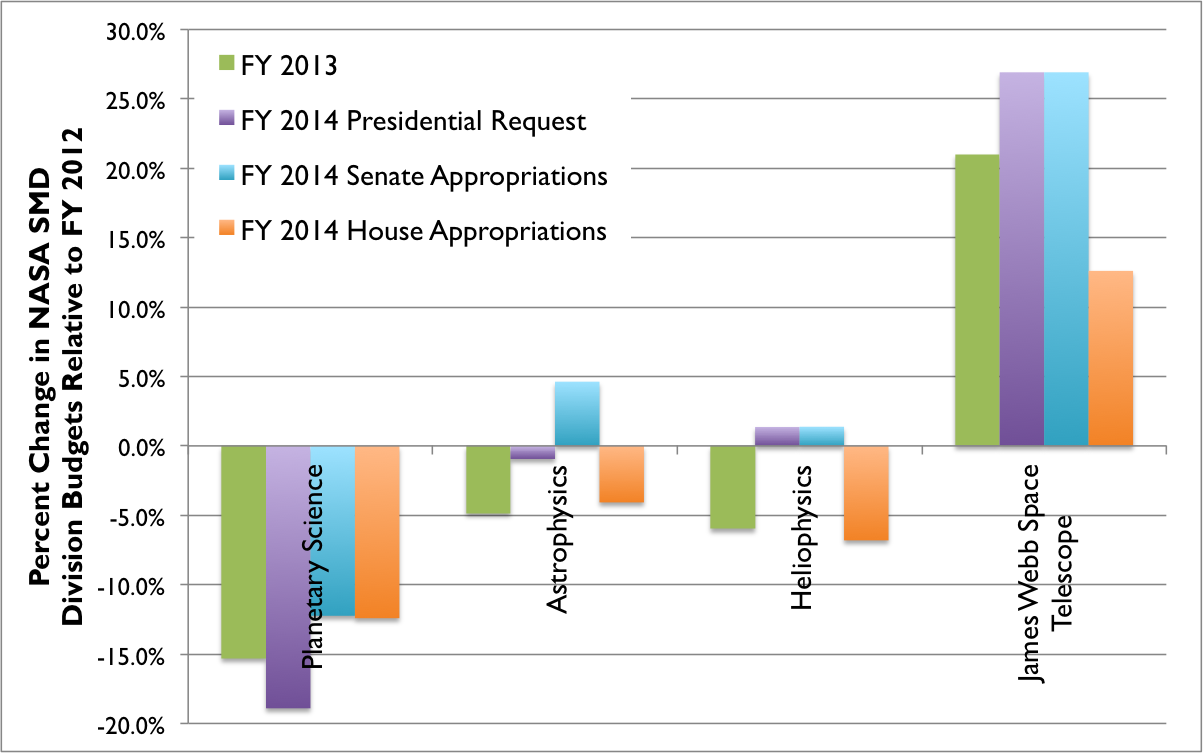The Astronomical Sciences in FY 2014: Below the Top Line at NASA
Josh Shiode
Last post, we took our first look at the potential budget for the coming fiscal year, FY 2014, which began 28 days ago. That's right, we're talking about the "outlook" for something that's already begun (you may have heard that Congress is having a hard time meeting deadlines lately).
As a quick reminder, here's the current budget situation. The relevant appropriations subcommitties in both chambers of Congress ("Commerce/Justice/Science" and "Energy & Water") have passed spending bills. However, nearly all of them are still awaiting consideration by the full House and Senate before potentially being "conferenced" between chambers and becoming law. The government is now (finally) funded via a continuing resolution, pinning funding levels at the sequestered levels of FY 2013; this is about 6% lower than FY 2012 for NASA's Science Mission Directorate. As part of the deal that ended the government shutdown and averted a US default, the House and Senate agreed to budget negotiations, in which they will attempt to work out the vast differences between their budget resolutions, which set the funding targets that the appropriations committees use to actually allocate funding. These discussions will not reach the level of detail below, but the exisiting appropriations bills were designed to meet what amounts to each side's opening bid in the negotiations. Thus, they give us an idea of how each chamber envisions the future of science research in a time when the federal government is driven largely by deficit reduction goals.
As already discussed, the Senate bills reflect their goal to restore the 2013 sequester cuts and strengthen investments, while the House's look to meet the sequestered budget caps for 2014 (i.e., potentially deepening cuts from the 2013 sequester). However, if we look a little deeper we find a more complicated picture. Let's begin with NASA, the agency that, today, provides most of the funding for our field.

Within NASA, funding for the astronomical sciences comes from the Science Mission Directorate (SMD), which houses separate Divisions for Earth Science, Planetary Science, Astrophysics, Heliophysics, and the James Webb Space Telescope (JWST). Webb was separated out of the Astrophyiscs division (like Hubble before it) as an "agency priority" in FY 2012. The budgetary changes relative to 2012 for each of the astronomical divisions are shown in the figure above.
For Hubble's infrared-focused successor, JWST, FY 2014 is scheduled to be the most expensive construction year. After a cost re-baselining and rescheduling in 2011, the 6.5m space telescope carries an estimated total pricetag (for the US) of $8.7 billion ($8 billion to launch) and a launch date in October 2018.* Despite recent rumors of further cost overruns and launch delays, the short government shutdown thankfully did nothing to change the mission cost or launch date thanks to smarter project management and 14 months of schedule reserve on hand. It seems that at least one rumor is related to confusion about total worldwide pricetag (about $10 billion) versus US pricetag (about $8.7 billion, as mentioned in the article linked above). While the two-week shutdown ate into available planned reserves but did not cause costly delays, the $74 million dollar cut proposed in the House appropriations bill would represent some 3-4 times the reserve funding designed into the budget to protect against more costly delays.**
Both the Astrophysics and Heliophysics Divisions see 8% differences between the House and Senate allocations, with the Senate apportioning more in both cases. For Astrophysics, the Senate allocates an additional $36 million above the presidential request, largely to provide funding for development of the top-astrophysics priority WFIRST mission; the House bill report provides no specific direction for distributing the cuts they propose. For Heliophysics, the Senate matches the Administration request, with specific support for the Magnetospheric Multiscale (MMS) and Solar Probe Plus missions, as well as the Heliophysics Explorer program. In Heliophysics, as in Astrophysics, the House report is silent on the distribution of proposed cuts.
The most detailed point of contention for both chambers is the Planetary Science division. Here, both the Senate and the House allocate about $100 million more than the presidential request (though still less than the division's budget in FY 2012 and prior). Each legislative body provides specific direction in the bill reports (linked above) about what select programs, and even missions within programs, should receive. The relative agreement between the two chambers versus the administration reflects a clear disagreement between the legislative and executive branches when it comes to Planetary Science. This largely began in 2012 when the administration proposed a $300 million decrease in the division's FY 2013 budget.
At the program level, the Senate language would specifically apportion funding to the OSIRIS-Rex mission, space technology development, and Near-Earth Object detection and characterization. The House, on the other hand, provides specific language targeting funding levels for research and analysis grants, the proposed Mars 2020 rover mission, and planning for a mission to Europa. This last item, despite not holding high priority within a constrained budget scenario in the recent decadal survey, comes at the request of Representative John Culberson of TX, who is ardent in his belief that there is life on Europa.
The soft-opening to the budget negotiations have been rolling out in the media over the last several days, with most predicting that the best case scenario is a one-year deal that replaces the across-the-board sequester spending cuts for FY 2014. We will continue to work alongside partners in Washington, like the broad Non-Defense Discretionary (NDD) United Coalition, to protect crucial discretionary investments like basic science research from further harmful cuts. It's important to keep in mind that we are all in the same boat, looking for a rising tide.
*This sentence has been edited to clarify the difference between total, life-cycle cost and cost to launch.
**This sentence has been edited to clarify the meaning of my phrasing "relatively easy to absorb."

